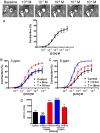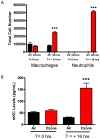20-HETE mediates ozone-induced, neutrophil-independent airway hyper-responsiveness in mice
- PMID: 20422032
- PMCID: PMC2857875
- DOI: 10.1371/journal.pone.0010235
20-HETE mediates ozone-induced, neutrophil-independent airway hyper-responsiveness in mice
Abstract
Background: Ozone, a pollutant known to induce airway hyper-responsiveness (AHR), increases morbidity and mortality in patients with obstructive airway diseases and asthma. We postulate oxidized lipids mediate in vivo ozone-induced AHR in murine airways.
Methodology/principal findings: Male BALB/c mice were exposed to ozone (3 or 6 ppm) or filtered air (controls) for 2 h. Precision cut lung slices (PCLS; 250 microm thickness) containing an intrapulmonary airway ( approximately 0.01 mm(2) lumen area) were prepared immediately after exposure or 16 h later. After 24 h, airways were contracted to carbachol (CCh). Log EC(50) and E(max) values were then calculated by measuring the airway lumen area with respect to baseline. In parallel studies, dexamethasone (2.5 mg/kg), or 1-aminobenzotriazol (ABT) (50 mg/kg) were given intraperitoneal injection to naïve mice 18 h prior to ozone exposure. Indomethacin (10 mg/kg) was administered 2 h prior. Cell counts, cytokine levels and liquid chromatography-mass spectrometry (LC-MS) for lipid analysis were assessed in bronchoalveolar lavage (BAL) fluid from ozone exposed and control mice. Ozone acutely induced AHR to CCh. Dexamethasone or indomethacin had little effect on the ozone-induced AHR; while, ABT, a cytochrome P450 inhibitor, markedly attenuated airway sensitivity. BAL fluid from ozone exposed animals, which did not contain an increase in neutrophils or interleukin (IL)-6 levels, increased airway sensitivity following in vitro incubation with a naïve PCLS. In parallel, significant increases in oxidized lipids were also identified using LC-MS with increases of 20-HETE that were decreased following ABT treatment.
Conclusions/significance: These data show that ozone acutely induces AHR to CCh independent of inflammation and is insensitive to steroid treatment or cyclooxygenase (COX) inhibition. BAL fluid from ozone exposed mice mimicked the effects of in vivo ozone exposure that were associated with marked increases in oxidized lipids. 20-HETE plays a pivotal role in mediating acute ozone-induced AHR.
Conflict of interest statement
Figures







Similar articles
-
Interleukin-1 receptor antagonist attenuates airway hyperresponsiveness following exposure to ozone.Am J Respir Cell Mol Biol. 2004 Jun;30(6):830-6. doi: 10.1165/rcmb.2003-0373OC. Epub 2004 Jan 30. Am J Respir Cell Mol Biol. 2004. PMID: 14754758
-
Prolonged ozone exposure in an allergic airway disease model: adaptation of airway responsiveness and airway remodeling.Respir Res. 2006 Feb 13;7(1):24. doi: 10.1186/1465-9921-7-24. Respir Res. 2006. PMID: 16472404 Free PMC article.
-
Ozone effects on airway responsiveness, lung injury, and inflammation. Comparative rat strain and in vivo/in vitro investigations.Inhal Toxicol. 1999 Nov;11(11):1015-40. doi: 10.1080/089583799196664. Inhal Toxicol. 1999. PMID: 10562695
-
Role of cathepsin S in ozone-induced airway hyperresponsiveness and inflammation.Pulm Pharmacol Ther. 2009 Feb;22(1):27-32. doi: 10.1016/j.pupt.2008.11.002. Epub 2008 Nov 14. Pulm Pharmacol Ther. 2009. PMID: 19041950
-
Role of IgE in the development of allergic airway inflammation and airway hyperresponsiveness--a murine model.Allergy. 1999 Apr;54(4):297-305. doi: 10.1034/j.1398-9995.1999.00085.x. Allergy. 1999. PMID: 10371087 Review.
Cited by
-
Clinical Implications of 20-Hydroxyeicosatetraenoic Acid in the Kidney, Liver, Lung and Brain: An Emerging Therapeutic Target.Pharmaceutics. 2017 Feb 20;9(1):9. doi: 10.3390/pharmaceutics9010009. Pharmaceutics. 2017. PMID: 28230738 Free PMC article. Review.
-
From bedside to bench to clinic trials: identifying new treatments for severe asthma.Dis Model Mech. 2013 Jul;6(4):877-88. doi: 10.1242/dmm.012070. Dis Model Mech. 2013. PMID: 23828644 Free PMC article. Review.
-
The influence of Hyssopus cuspidatus Boriss extract on lipid mediators metabolism network in asthmatic mice.Front Pharmacol. 2023 Mar 2;14:1066643. doi: 10.3389/fphar.2023.1066643. eCollection 2023. Front Pharmacol. 2023. PMID: 36937885 Free PMC article.
-
Asthma with Fixed Airflow Obstruction: From Fixed to Personalized Approach.J Pers Med. 2022 Feb 23;12(3):333. doi: 10.3390/jpm12030333. J Pers Med. 2022. PMID: 35330333 Free PMC article. Review.
-
Delineating asthma according to inflammation phenotypes with a focus on paucigranulocytic asthma.Chin Med J (Engl). 2023 Jul 5;136(13):1513-1522. doi: 10.1097/CM9.0000000000002456. Chin Med J (Engl). 2023. PMID: 37185590 Free PMC article. Review.
References
-
- Galan I, Tobias A, Banegas JR, Aranguez E. Short-term effects of air pollution on daily asthma emergency room admissions. Eur Respir J. 2003;22:802–808. - PubMed
-
- Medina-Ramon M, Zanobetti A, Schwartz J. The effect of ozone and PM10 on hospital admissions for pneumonia and chronic obstructive pulmonary disease: a national multicity study. Am J Epidemiol. 2006;163:579–588. - PubMed
-
- Stokstad E. Air-quality standards. EPA adjusts a smog standard to White House preference. Science. 2008;319:1602–1603. - PubMed
-
- Jorres RA, Holz O, Zachgo W, Timm P, Koschyk S, et al. The effect of repeated ozone exposures on inflammatory markers in bronchoalveolar lavage fluid and mucosal biopsies. Am J Respir Crit Care Med. 2000;161:1855–1861. - PubMed
Publication types
MeSH terms
Substances
Grants and funding
LinkOut - more resources
Full Text Sources
Medical

